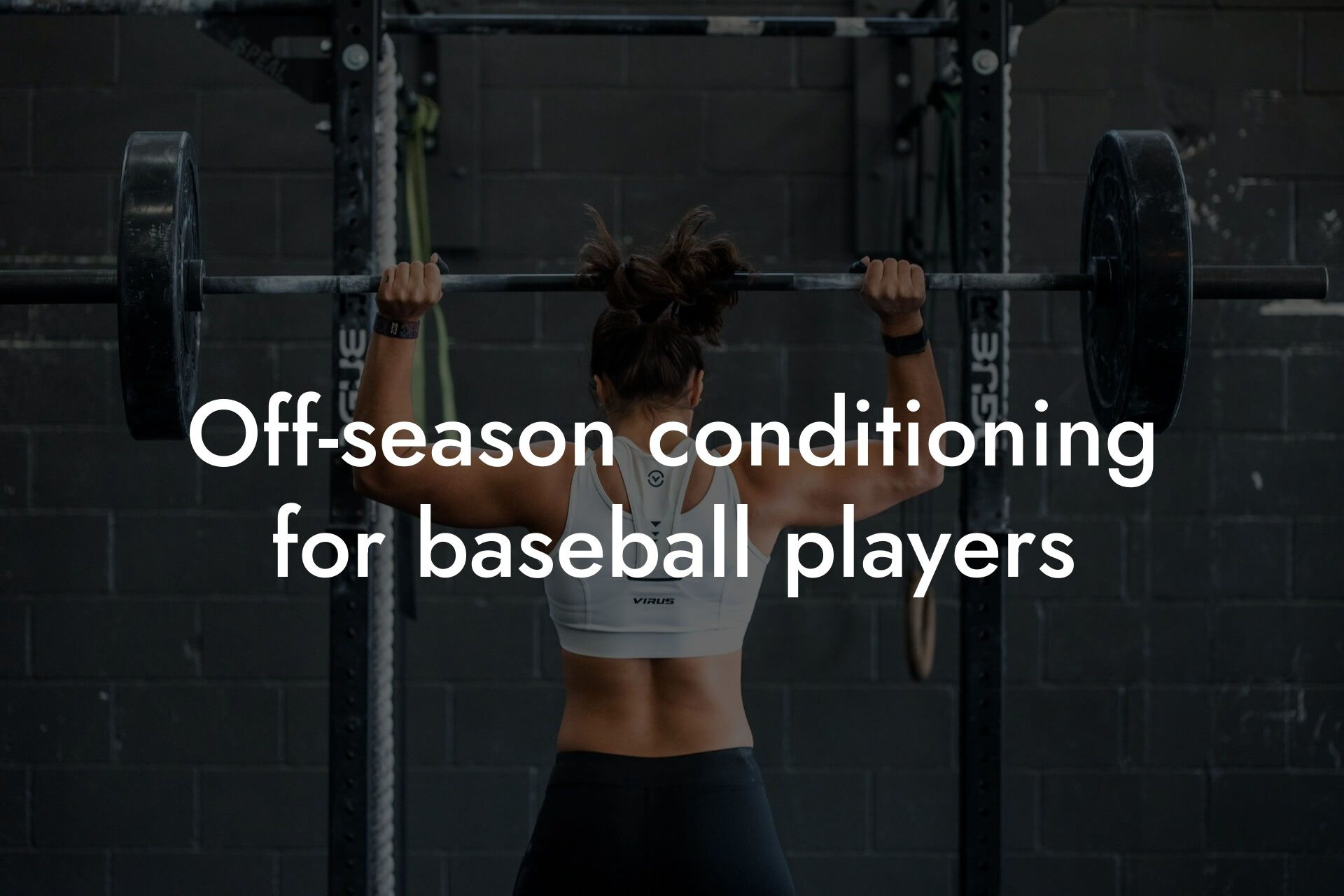As a high-earning professional, you understand the importance of being in top physical condition to perform at your best on the field. One key aspect of athletic performance is speed, and having excess body fat can significantly hinder your ability to move quickly and efficiently around the bases. In this article, we'll delve into the importance of reducing body fat for better speed, and provide you with a comprehensive guide on how to achieve it.
Table of Contents
Why Body Fat Matters for Speed
Excess body fat can slow you down in several ways. Firstly, it increases your overall weight, making it more difficult to accelerate and decelerate quickly. This is because your muscles have to work harder to move your body, which can lead to fatigue and decreased speed. Additionally, excess body fat can also affect your power-to-weight ratio, making it more challenging to generate the force needed to propel yourself quickly around the bases.
Furthermore, excess body fat can also impact your agility and quickness. When you're carrying extra weight, it can be more difficult to change direction quickly and make sharp cuts on the basepaths. This can put you at a disadvantage compared to leaner, more agile opponents.
The Ideal Body Fat Percentage for Baseball Players
So, what's the ideal body fat percentage for baseball players? The answer varies depending on the position and individual goals, but generally, a body fat percentage between 6-12% is considered optimal for baseball players. This range allows for a good balance between strength, power, and speed.
For example, a study published in the Journal of Strength and Conditioning Research found that baseball players with a body fat percentage of 8-10% were able to run faster and jump higher than those with higher body fat percentages. Another study published in the International Journal of Sports Physiology and Performance found that baseball players with a body fat percentage of 6-8% were able to perform better in agility drills and had faster 30-yard dash times.
How to Measure Body Fat Percentage
So, how do you measure your body fat percentage? There are several methods available, including skinfold measurements, bioelectrical impedance analysis (BIA), and dual-energy X-ray absorptiometry (DEXA). At Tano Performance Group, we use DEXA scans to provide our clients with a highly accurate and detailed body composition analysis.
DEXA scans use X-ray technology to measure bone density, lean mass, and fat mass, providing a comprehensive picture of your body composition. This information can be used to identify areas for improvement and track progress over time.
Nutrition Strategies for Reducing Body Fat
When it comes to reducing body fat, nutrition plays a critical role. Here are some key strategies to help you achieve your goals:
Create a calorie deficit: To lose body fat, you need to consume fewer calories than you burn. Aim for a daily calorie deficit of 500-1000 calories to promote weight loss while preserving lean mass.
Focus on whole foods: Eat a balanced diet rich in whole foods such as lean proteins, complex carbohydrates, and healthy fats. Avoid processed and high-calorie foods that can hinder weight loss.
Increase protein intake: Protein is essential for building and maintaining lean mass. Aim for 1.6-2.2 grams of protein per kilogram of body weight daily.
Stay hydrated: Adequate hydration is critical for overall health and athletic performance. Aim for at least 8-10 glasses of water per day.
Training Strategies for Reducing Body Fat
In addition to nutrition, training also plays a key role in reducing body fat. Here are some key strategies to help you achieve your goals:
Incorporate high-intensity interval training (HIIT): HIIT involves short bursts of high-intensity exercise followed by brief periods of rest. This type of training has been shown to be effective for burning fat and improving cardiovascular fitness.
Focus on resistance training: Resistance training helps build and maintain lean mass, which is critical for athletic performance. Focus on exercises that work multiple muscle groups at once, such as squats, deadlifts, and bench press.
Incorporate plyometric exercises: Plyometric exercises, such as jump squats and box jumps, can help improve power and explosiveness.
Supplementation for Reducing Body Fat
In addition to nutrition and training, certain supplements can also help support fat loss. Here are some key options to consider:
Protein powder: Protein powder can help increase protein intake and support lean mass growth.
Creatine: Creatine is a naturally occurring substance that can help increase power and endurance.
Fish oil: Fish oil is rich in omega-3 fatty acids, which can help reduce inflammation and support overall health.
Sample Workout and Nutrition Plan
Here's a sample workout and nutrition plan to help you get started:
Workout:
Monday (Chest and Triceps):
- Bench press (3 sets of 8-12 reps)
- Incline dumbbell press (3 sets of 10-15 reps)
- Tricep pushdown (3 sets of 12-15 reps)
- Tricep dips (3 sets of 12-15 reps)
Nutrition:
- Breakfast: 3 whole eggs, 2 egg whites, 2 slices of whole wheat toast, and 1 cup of oatmeal
- Lunch: 4 oz of grilled chicken, 1 cup of brown rice, and 1 cup of steamed vegetables
- Dinner: 6 oz of grilled salmon, 1 cup of sweet potato, and 1 cup of mixed greens salad
- Snack: 1 scoop of protein powder, 1 cup of Greek yogurt, and 1 cup of mixed berries
Reducing body fat is critical for improving speed and overall athletic performance. By understanding the importance of body fat, measuring your body fat percentage, and implementing effective nutrition and training strategies, you can achieve your goals and take your game to the next level. Remember to stay patient, consistent, and focused, and don't be afraid to seek guidance from a qualified healthcare professional or certified trainer. With the right approach, you can achieve the lean, athletic physique you need to dominate on the bases.
Frequently Asked Questions
What is the importance of reducing body fat for better speed on the bases?
Reducing body fat is crucial for improving speed on the bases because excess body fat can increase your overall weight, reducing your power-to-weight ratio and making it more difficult to accelerate and decelerate quickly. By reducing body fat, you can improve your speed, agility, and overall athletic performance.
How does body fat affect my speed on the bases?
Body fat can affect your speed on the bases in several ways. Excess body fat can increase your overall weight, reducing your power-to-weight ratio and making it more difficult to accelerate and decelerate quickly. Additionally, body fat can also affect your flexibility, mobility, and reaction time, making it harder to quickly change direction and accelerate.
What is the ideal body fat percentage for athletes?
The ideal body fat percentage for athletes varies depending on the sport and position. However, for baseball players, a body fat percentage of 10-12% is generally considered ideal for optimal performance.
How can I measure my body fat percentage?
There are several ways to measure body fat percentage, including dual-energy X-ray absorptiometry (DXA), hydrostatic weighing, and skinfold measurements. You can also use a body fat caliper to estimate your body fat percentage.
What is the difference between lean body mass and body fat?
Lean body mass refers to the weight of your muscles, bones, and other non-fat tissues. Body fat, on the other hand, refers to the weight of your fat tissues. Having a high lean body mass and low body fat percentage is ideal for athletes.
How can I reduce my body fat percentage?
Reducing body fat percentage requires a combination of proper nutrition, regular exercise, and patience. Focus on eating a balanced diet with plenty of protein, healthy fats, and complex carbohydrates, and engage in regular cardio and strength training exercises to burn fat and build lean muscle mass.
What types of exercises are best for reducing body fat?
High-intensity interval training (HIIT) and strength training exercises are effective for reducing body fat. These types of exercises help you burn fat and build lean muscle mass, which can improve your overall athletic performance.
How often should I exercise to reduce body fat?
Aim to exercise at least 3-4 times per week, with at least one day of rest in between. This allows your body to recover and rebuild muscle tissue, which is important for reducing body fat and improving athletic performance.
What is the role of nutrition in reducing body fat?
Nutrition plays a critical role in reducing body fat. Focus on eating a balanced diet with plenty of protein, healthy fats, and complex carbohydrates, and avoid processed and high-calorie foods that can hinder fat loss.
How can I ensure I'm getting enough protein to support muscle growth and fat loss?
Aim to consume at least 1-1.5 grams of protein per kilogram of body weight daily, spread out over 3-5 meals. Good sources of protein include lean meats, fish, eggs, dairy, and plant-based options like beans and tofu.
What are some healthy sources of carbohydrates for athletes?
Healthy sources of carbohydrates for athletes include whole grains, fruits, vegetables, and legumes. These foods provide energy and fiber, which can help support athletic performance and overall health.
How can I stay hydrated during exercise and competition?
Aim to drink at least 8-10 glasses of water per day, and make sure to drink water or a sports drink during exercise and competition to stay hydrated and prevent dehydration.
What are some common mistakes athletes make when trying to reduce body fat?
Common mistakes athletes make when trying to reduce body fat include crash dieting, overtraining, and neglecting proper nutrition. These mistakes can lead to fatigue, injury, and poor athletic performance.
How long does it take to see results from a fat loss program?
The amount of time it takes to see results from a fat loss program varies depending on individual factors, such as starting body fat percentage, diet, and exercise habits. However, with a consistent and well-structured program, you can expect to see noticeable results within 6-12 weeks.
Can I reduce body fat too quickly?
Yes, reducing body fat too quickly can be harmful to your health and athletic performance. Aim to lose 0.5-1% body fat per week for a safe and sustainable rate of fat loss.
How can I maintain my new body fat percentage once I've reached my goal?
To maintain your new body fat percentage, focus on making sustainable lifestyle changes, such as healthy eating habits and regular exercise, rather than trying fad diets or quick fixes.
What role does sleep play in reducing body fat?
Sleep plays a critical role in reducing body fat by helping to regulate hunger hormones, support muscle recovery, and improve overall athletic performance. Aim for 7-9 hours of sleep per night.
Can I reduce body fat without losing muscle mass?
Yes, it is possible to reduce body fat without losing muscle mass. Focus on eating a balanced diet with plenty of protein, and engage in regular strength training exercises to build and maintain lean muscle mass.
How can I track my progress and stay motivated?
Track your progress by taking body fat measurements, weight, and progress photos regularly. Stay motivated by setting realistic goals, finding a workout buddy, and rewarding yourself for small milestones achieved.
What are some common myths about reducing body fat?
Common myths about reducing body fat include the idea that you need to do hours of cardio per day, or that you need to cut out entire food groups to lose fat. These myths can be harmful and ineffective, and may even lead to poor athletic performance and overall health.
How can I get personalized guidance on reducing body fat and improving athletic performance?
Consult with a qualified coach, trainer, or registered dietitian who can provide personalized guidance and support to help you achieve your goals.
What are some additional resources for learning more about reducing body fat and improving athletic performance?
Additional resources for learning more about reducing body fat and improving athletic performance include books, online articles, and websites like Tano Performance Group, which provide evidence-based information and expert guidance.
Here are some related articles you might love...
- How DEXA scans can help baseball players optimize performance
- Recovery strategies for baseball athletes
- Off-season conditioning for baseball players
- Strength training programs for baseball athletes
- Balancing muscle mass and flexibility in baseball
- The importance of core strength in baseball performance
- The role of body composition in baseball power and endurance
- Nutrition strategies for maintaining muscle during the baseball season
- Bone density and its impact on injury prevention in baseball
Zak Faulkner
Zak Faulkner is a leading authority in the realm of physical health and body composition analysis, with over 15 years of experience helping professionals optimise their fitness and well-being. As one the experts behind Tano Performance Group, Zak has dedicated his career to providing in-depth, science-backed insights that empower clients to elevate their physical performance and overall health.
With extensive knowledge of DEXA technology, Zak specializes in delivering comprehensive body assessments that offer precise data on body fat, muscle mass, bone density, and overall physique. His expertise enables individuals to make informed decisions and achieve their fitness goals with accuracy and confidence. Zak’s approach is rooted in a deep understanding of human physiology, combined with a passion for helping clients unlock their full potential through personalised strategies.
Over the years, Zak has earned a reputation for his commitment to excellence, precision, and client-focused service. His guidance is trusted by top professionals who demand the best when it comes to their health. Whether advising on fitness programs, nutritional strategies, or long-term wellness plans, Zak Faulkner’s insights are a valuable resource for anyone serious about taking their health and fitness to the next level.
At Tano Performance Group, Zak continues to lead our Content Team revolutionising how professionals approach their physical health, offering unparalleled expertise that drives real results.




